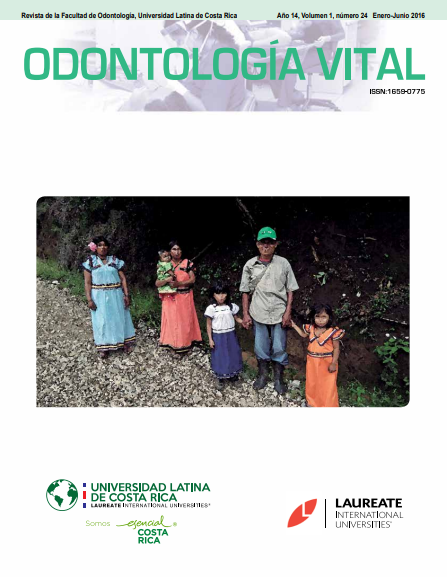Prevalence of proximal lesions in molars according to ICDAS II and its correlation with the radiographic diagnosis, in children aged 4-9 years old. Prevalence of proximal lesions in molars according to ICDAS II and its correlation with the radiographic di
DOI:
https://doi.org/10.59334/ROV.v1i24.262Keywords:
Interproximal carious lesions, ICDAS II, radiographic diagnosisAbstract
Tooth decay refers to a condition characterized by progressive demineralization, through the first clinical
manifestations, to loss of tooth structure itself. The diagnosis of dental caries was limited only to an endpoint,
cavity and at last, tooth loss. Now days it is considered tooth decay as a whole disease process. The disease
remains a public health problem. The correct diagnosis of dental caries is essential to diminish this problem,
including difficult access areas like the interproximal carious lesions. Performing visual clinical diagnosis in
the proximal surface is almost impossible, and in many cases false negatives are given in the diagnosis, so it is
necessary to use complementary methods such as x-rays. In this study both the visual clinical method ICDAS
II (International Caries Detection and Assessment System) and the radiographic diagnostic method where
used. When performing visual clinical examination of the proximal surfaces of molars, orthodontic separators
achieved temporary separation of the tooth, so it allowed a physical space to facilitate clinical evaluation and
implemented ICDAS II as an instrument used for evaluating the severity levels of caries process in different areas;
x rays were taken on the same tooth surfaces, valued with the visual clinical examination. The main objective
was to determine the prevalence of interproximal lesions in molars according to the criteria of assessment and
detection of ICDAS II caries and its correlation with the diagnosis of the same injury observed with radiographic
method. 18.7% Surfaces observed with clinical diagnostic method with orthodontics separators showed surfaces
with carious lesions, while the radiographic diagnosis method presented 22.5% of surfaces with carious lesions;
a strong association between visual clinical diagnosis and radiographic diagnosis, with a 91.1% probability of
finding the same results with statistical significance, allowing a generalization of the results
Downloads
Downloads
Published
How to Cite
Issue
Section
License
Copyright (c) 2016 Odontología Vital

This work is licensed under a Creative Commons Attribution 4.0 International License.
Authors who publish with Odontología Vital agree to the following terms:
- Authors retain the copyright and grant Universidad Latina de Costa Rica the right of first publication, with the work simultaneously licensed under a Creative Commons Attribution 4.0 International license (CC BY 4.0) that allows others to share the work with an acknowledgement of the work's authorship and initial publication in this journal.
- Authors are able to enter into separate, additional contractual arrangements for the non-exclusive distribution of the Odontología Vital's published version of the work (e.g., post it to an institutional repository or publish it in a book), with an acknowledgement of its initial publication.
- Authors are permitted and encouraged to post their work online (e.g., in institutional repositories or on their website) prior to and during the submission process, as it can lead to productive exchanges, as well as earlier and greater citation of published work.
Métricas alternativas











